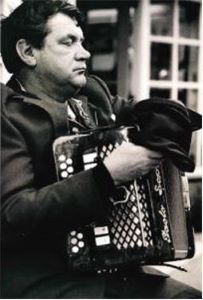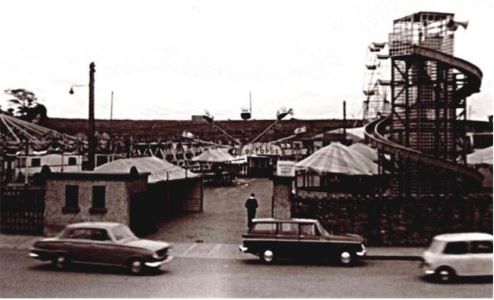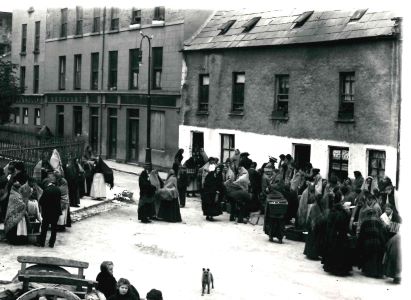Old Galway
THE CURRACH RACES, SALTHILL

by Tom Kenny
The Currach Races …. An Tóstal …. Rásaí na gCurrachaí …. 60,000 people plus in Salthill ….. Lines of people four and five deep along the prom …. Every vantage point taken …..Specially designed currachs everywhere, up on trailers, sitting on grass verges, at the water’s edge …. Always a crowd of people inspecting them …. The currachs on the sea like tiny insects, indistinguishable in the mist and drizzle …. Mountainy men and island men … Báinín …. Bréidín ….. Beautiful hand-knit Aran croiseanna …. Caps ….. Caps ….. Thousands of caps ….. Women in many different styles of shawl …. Some red petticoats …. Stalls everywhere selling minerals, sweets, fruit …… Many stages erected along the prom hosting sean nós singers, dancers, traditional musicians …. The atmosphere of a massive aeríocht …. Programmes written in the old Irish script ….. Strange accents from Donegal …. Three-card trick men ….. Canoe races between the currach races …. Trawlers marking the race route ….. Kerry accents ….. Canúint Chonamara …. A cluster of bookies at Blackrock …. Bottles of stout and lemonade …. Gaelinn spoken in lilting Cork accents ….. Gaeilge spoken by Aran Islanders who had come in on the Dún Aengus …. A marquee for food at Blackrock … Another for visiting crews …. The Joyces of Inis Bearacháin …. Bands playing at the Ladies Beach and at Blackrock …. Currach men from Mayo, Sligo and Clare …. Commentary on the races blaring from speakers all over Salthill …. A festival dance in the Hangar …. This was the All-Ireland Currach Racing Championship which was first held in 1953 in the Claddagh and thereafter for several years in Salthill. The prom provided the ideal viewing stand, the oarsmen provided the excitement and the crowds provided the atmosphere.
JOSEPH GAYNOR, A GALWAY BUSKER

by Tom Kenny
Busking is the practice of performing in public places, street performances for tips or gratuities, voluntary donations. It may come from the Spanish word Buscar – to seek (fame and fortune) or the Latin word Buscare, to procure, to gain.
THE DÚN AENGUS

by Tom Kenny
The first steamer service to the Aran Islands began almost 150 years ago, in 1872, with a paddle tug called “The Citie of the Tribes”. She was operated by the Galway Steamship Company and was also used to tow barques and other sailing vessels to and from Galway port.
OLD GALWAY NEWSPAPERS

by Tom Kenny
The first book printed in Ireland was The Book of Common Prayer in 1551. As printing became more sophisticated, newspapers became inevitable. The first gazettes were published originally in manuscript – the word gazette being derived from gazetto, a coin of Venice, the amount paid for reading the news. The earliest printed newspapers began to appear around the end of the 16th century. These were small, quarto in size, printed on one or both sides of the page, or of four pages containing intelligence of public interest which were variously called 'Books of Newes', ‘Newe Newes’, 'Wonderful Newes', ‘Bloody Newes out of Ireland’, etc.
THE ‘AMUSEMENTS’ IN THE FAIRGREEN

by Tom Kenny
It is good to see funfair being set up at the moment along the Prom, a sure sign that the summer is on the way. There has been a history of summer funfairs in Galway for well over a hundred years, though they were always known here as ‘the Amusements’. In the early days, the Toft family used to organise them in Salthill Park. Occasionally, the neighbours used to object to the noise and the traffic and on at least one occasion, they were invited next door on to the site in front of Dr. O’Beirne’s house (where Leisureland is today).
THE EGG AND BUTTER MARKET IN CHURCH STREET

by Tom Kenny
Some weeks ago we wrote about the virtues of country butter being sold at the Saturday Market, but it seems there were occasional vices there too. The ink was hardly dry on the paper when David Barrett sent us an account of a court case that took place at the Galway Petty Sessions in September 1910 before the magistrates Messrs. J. Kilbride and J.S. Young. District Inspector Hildebrand, prosecuted Mrs. Sarah Bane, Moycullen on three different counts of selling butter that was unfit for human consumption to Kate Hoare, Mary Griffin and Norah Joyce. Mr. Cooke, from Blake and Kenny solicitors, appeared for the defence.
CLAY PIPES AND DÚIDÍNS

by Tom Kenny
In the days before cigarettes were invented, clay pipes were very popular and could be found in most houses in the country. They were mainly used by working class people, easy to purchase, mass produced, cheap and light and smoked by men and women. The short stemmed version was known as a dúidín or dudeen in Ireland, as a cutty in Scotland and a ‘nose warmer’ in England. The longer version was known as the Beannacht Dé pipes or ‘The Lord ha’ mercy’ pipe, as that was how people invariably responded when you gave them one, “Beannacht Dé Leat”.
REILLY’S HOTEL, SALTHILL

by Tom Kenny
This small hotel owned by Mrs. B. O’Sullivan was prominently situated in Salthill (near where Seapoint is today), fully licensed, hot and cold running water in all bedrooms and had a large bungalow in the grounds at the back.
On May 14th 1921, John Green, a student from Sligo was staying there sharing a room with Patrick McDonagh and Gerald Hanley. James Egan, an insurance inspector from Mayo was also staying. On this night, the three in the room were in bed when they heard shots downstairs, then two RIC men, quite drunk, came into the room, talked amicably for a while, then left but fired about a dozen shots back through the bedroom door. Obviously they were confused by drink and came back and dragged Green and Hanley out in their pyjamas. As Green toppled down the stairs, he found James Egan lying in his own blood.
.png)